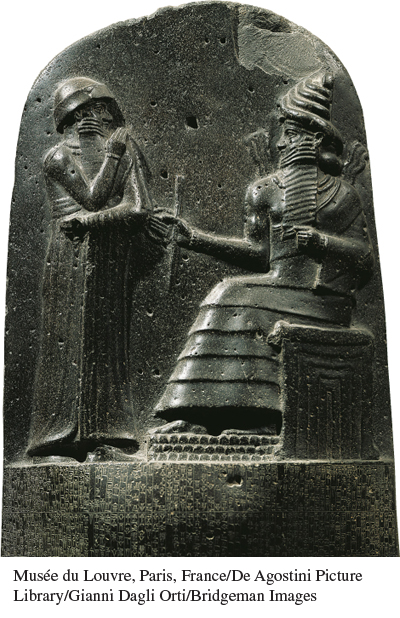Life Under Hammurabi

20
Hammurabi of Babylon (r. 1792–1750 B.C.E.) was initially a typical king of his era. As ruler of Babylon, he fought some of his neighbors, created treaties with others, taxed his people, expanded the city walls, and built temples. After he had ruled for thirty years, Babylon was attacked, and one of Hammurabi’s allies did not provide the assistance he expected. Hammurabi defeated the attackers and also conquered his former ally and several other kingdoms, thus uniting most of Mesopotamia under his rule. The era from his reign to around 1595 B.C.E. is called the Old Babylonian period.
As had earlier rulers, Hammurabi linked his success with the will of the gods. He connected himself with the sun-
Hammurabi’s most memorable accomplishment was the proclamation of an extensive law code, introduced about 1755 B.C.E. Hammurabi’s was not the first law code in Mesopotamia; the earliest goes back to about 2100 B.C.E. Like the codes of the earlier lawgivers, Hammurabi’s law code proclaimed that he issued his laws on divine authority “to establish law and justice in the language of the land, thereby promoting the welfare of the people.” Hammurabi’s code set a variety of punishments for breaking the law, including fines and physical punishment such as mutilation, whipping, and burning.
Hammurabi’s code provides a wealth of information about daily life in Mesopotamia, although, like all law codes, it prescribes what the lawgivers hope will be the situation rather than providing a description of real life. We cannot know if its laws were enforced, but we can use it to see what was significant to people in Hammurabi’s society. Because of farming’s fundamental importance, the code dealt extensively with agriculture. Tenants faced severe penalties for neglecting the land or not working it at all. Since irrigation was essential to grow crops, tenants had to keep the canals and ditches in good repair. Anyone whose neglect of the canals resulted in damaged crops had to bear all the expense of the lost crops. Those tenants who could not pay the costs were forced into slavery.
Hammurabi gave careful attention to marriage and the family. As elsewhere in the Near East, marriage had aspects of a business agreement. The groom or his father offered the prospective bride’s father a gift, and if this was acceptable, the bride’s father provided his daughter with a dowry. As in Sumer, after marriage the dowry belonged to the woman (although the husband normally administered it) and was a means of protecting her rights and status. No marriage was considered legal without a contract, and although either party could break off the marriage, the cost was a stiff penalty. Fathers often contracted marriages while their children were still young, and once contracted, the children were considered to be wed even if they did not live together. Men were not allowed to take a second wife unless the first wife could not bear children or had a severe illness.
The penalty for adultery, defined as sex between a married woman and a man not her husband, was death. According to Hammurabi’s code, “If the wife of a man has been caught while lying with another man, they shall bind them and throw them into the water.”3 A husband had the power to spare his wife by obtaining a pardon for her from the king. He could, however, accuse his wife of adultery even if he had not caught her in the act. In such a case she could try to clear herself, and if she was found innocent, she could take her dowry and leave her husband.
21
A father could not disinherit a son without just cause, and the code ordered the courts to forgive a son for his first offense. Men could adopt children into their families and include them in their wills, which artisans sometimes did to teach them the family trade, or wealthy landowners sometimes did to pass along land to able younger men, particularly if they had no children of their own.
The Code of Hammurabi demanded that the punishment fit the crime, calling for “an eye for an eye, and a tooth for a tooth,” at least among equals. However, a higher-
Hammurabi’s code began with legal procedure. There were no public prosecutors or district attorneys, so individuals brought their own complaints before the court. Each side had to produce witnesses to support its case. In cases of murder, the accuser had to prove the defendant guilty; any accuser who failed to do so was to be put to death. Another procedural regulation declared that once a judge had rendered a verdict, he could not change it. Anyone accused of witchcraft, even if the charges were not proved, underwent an ordeal by water. The defendant was thrown into the Euphrates, which was considered the instrument of the gods. A defendant who sank was guilty; a defendant who survived was innocent.
Consumer protection is not a modern idea; it goes back to Hammurabi’s day. Merchants had to guarantee the quality of their goods and services. A boat builder who did sloppy work had to repair the boat at his own expense. House builders guaranteed their work with their lives. If inhabitants died when a house collapsed, the builder was put to death. A merchant who tried to increase the interest rate on a loan forfeited the entire amount. In these ways, Hammurabi’s laws tried to ensure that consumers got what they paid for and paid a just price.
The practical impact of Hammurabi’s code is much debated. There is disagreement about whether it recorded laws already established, promulgated new laws, recorded previous judicial decisions, or simply proclaimed what was just and proper. It is also unknown whether Hammurabi’s proclamation was legally binding on the courts. Nevertheless, Hammurabi’s code gives historians a valuable view into the lives of the Mesopotamians, and it influenced other law codes of the Near East, including those later written down in Hebrew Scripture.